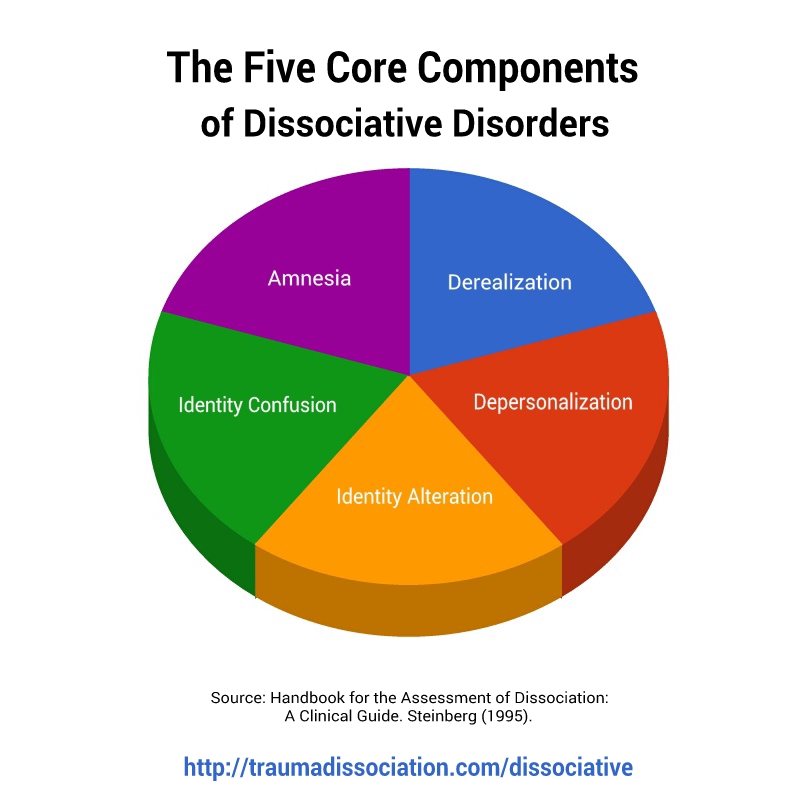DSM-5 Dissociative Disorders

The newest guide to psychiatric diagnosis is the DSM-5, released in 2013.[1] It lists these Dissociative Disorders:
Dissociative identity disorder (DID) DSM5 code 300.14 (ICD-10 F44.81)
Dissociative amnesia including Dissociative Fugue DSM5 code 300.12 (ICD-10 F44.0)
Depersonalization/Derealization disorder DSM5 code 300.6 (ICD-10 F48.1)
Other Specified Dissociative Disorder DSM5 code 300.16 (ICD-10 F44.89)
Unspecified Dissociative Disorder DSM5 code 300.15 (ICD-10 F44.9)
DSM-5 Conversion Disorders which are Dissociative Disorders in the ICD-10
The other main diagnostic manual is the International Classification of Diseases (ICD-11), which the World Health Organisation.[2]Dissociative Disorders of movement or sensation DSM5 300.11 (ICD-10 F44.4, F44.5, F44.6)
The Core Symptoms of Dissociative Disorders
Dr Marlene Steinberg, who developed the Structured Clinical Interview for Dissociative Disorders to assess dissociation, analyzed the characteristics of dissociative disorders, finding that each dissociative disorder could be described and understood using a combination of one of five core symptoms:
- amnesia recurrent memory problems, often described as "losing time", these gaps in memory can vary from several minutes to years
- depersonalization a sense of detachment or disconnection from one’s self, this can include feeling like a stranger to yourself, feeling detached from your emotions, feeling robotic or like you are on autopilot, or feeling like a part of your body does not belong to you. Some people self-injure when depersonalized, for example in order to feel "real".
- derealization a sense of disconnection from familiar people or one’s surroundings, for example, close relatives or your own home may seem unreal or foreign. Episodes of derealization may happen during flashbacks; you may suddenly feel much younger and feel your present environment is unreal during this time.
- identity confusion an inner struggle about one’s sense of self/identity, which may involve uncertainty, puzzlement or conflict. Severe identity confusion regarding sexual identity has been reported in people who have been sexually abused.
- identity alteration a sense of acting like a different person some of the time Recognizable signs of identity alteration include using of different names in different situations, discovering you have items you don't recognize, or having a learned skill which you have no recollection of learning. Mild identity alteration is widespread in the non-clinical population and does not cause difficulties for the person, for example a person assumes different roles but remained aware of this alteration. Mood or behavior changes which don't feel under your control, but don't involve using different names or changes in memory or perceived age, etc, indicate moderate identity alteration. This is common in non-dissociative disorders, for example in borderline personality disorder. [6, 7:9-12, 232]
References
1. Black, Donald W. (2014) (coauthors: Grant, Jon E.). DSM-5 Guidebook: The Essential Companion to the Diagnostic and Statistical Manual of Mental Disorders, Fifth Edition. American Psychiatric Pub. ISBN 9781585624652.
2. World Health Organisation. (2014) Classification of Diseases (ICD). Retrieved November 16, 2014, from http://www.who.int/classifications/icd/revision/en/
3. Task Force on Nomenclature and Statistics American Psychiatric Association. (1980). Diagnostic and statistical manual of mental disorders (3d ed.). Washington, D.C.: American Psychiatric Association.
4. American Psychiatric Association. Task Force on DSM-IV. (1994). Diagnostic and statistical manual of mental disorders: DSM-IV. (4th ed.). Washington, DC: American Psychiatric Association. ISBN 0890420610.
5. American Psychiatric Association. (2013). Diagnostic and statistical manual of mental disorders: DSM-5. (5th ed.). Washington, D.C.: American Psychiatric Association. ISBN 0890425558.
6. Steinberg, M., & Schnall, M. (2001). The Stranger in the Mirror: Dissociation-The Hidden Epidemic.HarperCollins. ISBN 0060954876, ISBN 0062063227.
7. Steinberg, M. (1995). Handbook for the Assessment of Dissociation: A Clinical Guide. American Psychiatric Pub. ISBN 0880486821.
Cite this page
Traumadissociation.com Dissociative Disorders. Retrieved from .This information can be copied or modified for any purpose, including commercially, provided a link back is included. License: CC BY-SA 4.0
